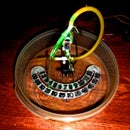Introduction: Change the Backlighting Color on a SideWinder X4 Keyboard
Microsoft's SideWinder X4 is a low-cost, backlit, gaming keyboard, and one of the very few to feature anti-ghosting technology that isn't limited to some small region of the keyboard. Typically, this feature has only been available on very high-end keyboards. This has made the X4 a hit with budget-minded gamers.
Unfortunately, not everyone loves the color of the backlighting. The X4 features a brilliant red backlight. But many people prefer blue, or even green. In this Instructable, I will show you how easy and inexpensive it is to change the backlighting to a different color. Please note that doing this will void your warranty.
Step 1: Gather Materials
The keys are backlit by 10 small, rectangular, red LEDs. They are an unusual size, but I have found some 1.8mm LEDs that fit nicely. These are available from HB Electronic Components:
http://www.hebeiltd.com.cn/?p=leds.1.8mm
They also have a U.S. distributor:
http://leading-leds.com/1.8mm.html
Shipping will probably cost far more than the handful of LEDs, so you might want to stock up, or do a joint buy with firends. You will need at least 10 LEDs of your choosen color. I would buy some extra in case you break or lose some.
http://www.hebeiltd.com.cn/?p=leds.1.8mm
They also have a U.S. distributor:
http://leading-leds.com/1.8mm.html
Shipping will probably cost far more than the handful of LEDs, so you might want to stock up, or do a joint buy with firends. You will need at least 10 LEDs of your choosen color. I would buy some extra in case you break or lose some.
Step 2: Open the Keyboard
There are 14 large screws and 6 small screws that must be removed to open the case. One of the screws is hidden under the Health Warning label. Another is under the left foot.
Remove all of the screws. You will then need to pry the top from the bottom. There are plastic tabs all around the edge, so don't be surprised if it takes a fair amount of force to get it open. The good news is that it goes back together much more easily than it comes apart.
Remove all of the screws. You will then need to pry the top from the bottom. There are plastic tabs all around the edge, so don't be surprised if it takes a fair amount of force to get it open. The good news is that it goes back together much more easily than it comes apart.
Step 3: Remove the Backlighting Boards
There are three long, narrow boards under the wrist rest that hold the 10 backlighting LEDs. Before removing these, note how they sit, and how the wiring is routed along the edge.
Slide off the connector on the first board. This will allow you to remove all three boards.
Slide off the connector on the first board. This will allow you to remove all three boards.
Step 4: Remove the Old LEDs
Desolder the 10 LEDs. This can be easily accomplished by heating both leads simultaneously while gently pulling the LED out.
After the LEDs are removed, use Solder Wick or some other method to remove any remaining solder from the holes.
After the LEDs are removed, use Solder Wick or some other method to remove any remaining solder from the holes.
Step 5: Install the New LEDs
Insert the new LEDs with the correct orientation and solder them into place. To help guide you, there is a small square next to the hole for the anode (the longer lead).
(Note: If you do them all backwards by mistake you can just flip the first connector to fix it.)
(Note: If you do them all backwards by mistake you can just flip the first connector to fix it.)
Step 6: Insert the Backlighting Boards
Insert the backlighting boards back into the keyboard. You will need to lift the sheet of silicone domes and the membranes to fit them properly underneath. Reconnect all the connectors and make sure that they are routed as they were previously.
At this point, it is wise to test your work. Plug the keyboard in to verify that the LEDs are functioning as expected.
At this point, it is wise to test your work. Plug the keyboard in to verify that the LEDs are functioning as expected.
Step 7: Close and Enjoy!
To close up the keyboard, first verify that the wires are routed properly and that the membranes and silicone dome sheet are seated correctly. There are posts which extend into the domes, so feel around to make sure that these are fully inserted. There are also some rubber pieces that surround the indicator lights. Verify that these are also seated correctly.
Once everything looks good, lower the top side (with the keys) onto the bottom. Press around the edges to resaeat all of the tabs. Then, flip the unit over, and install the 20 screws.
You are now ready to enjoy your keyboard! Note that the dimmer control works as expected.
Final note for more advanced DIYers:You can increase the brightness somewhat by changing the resistors on the backlight boards. Because these new LEDs will have a higher voltage drop than the original LEDs, you can lower the resistor values somewhat while still drawing only as much power as the original design.
Once everything looks good, lower the top side (with the keys) onto the bottom. Press around the edges to resaeat all of the tabs. Then, flip the unit over, and install the 20 screws.
You are now ready to enjoy your keyboard! Note that the dimmer control works as expected.
Final note for more advanced DIYers:You can increase the brightness somewhat by changing the resistors on the backlight boards. Because these new LEDs will have a higher voltage drop than the original LEDs, you can lower the resistor values somewhat while still drawing only as much power as the original design.





